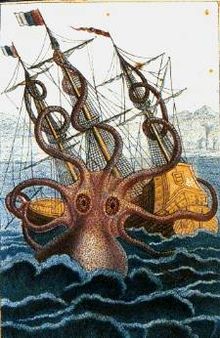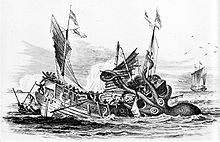- Kraken
-
Kraken 
The colossal octopus: a drawing by malacologist Pierre Dénys de Montfort (1801) (based on descriptions by French sailors).Mythology Norse Grouping Legendary creature Sub-grouping Sea monster Country Greenland Habitat Greenland Sea Kraken (
 /ˈkreɪkən/ or /ˈkrɑːkən/)[1] are legendary sea monsters of giant proportions said to have dwelt off the coasts of Norway and Iceland.
/ˈkreɪkən/ or /ˈkrɑːkən/)[1] are legendary sea monsters of giant proportions said to have dwelt off the coasts of Norway and Iceland.In modern German, Krake (plural and declined singular: Kraken) means octopus but can also refer to the legendary Kraken.[2] In Norwegian, Kraken is the definite form of krake, a word that can refer to the legendary creature (can also mean "frail, poor being", or "crooked, withered tree").[3]
Although fictional and the subject of myth, the legend of the Kraken continues to present day,[4], with numerous references existing in popular culture, including film, literature, television, video games and other miscellaneous examples (e.g. postage stamps, a rollercoaster ride and a rum product).
Contents
History
The Old Icelandic saga Örvar-Odds saga referenced the massive heather-backed sea-monsters of the Greenland Sea named Hafgufa and Lyngbakr that fed on whales, ships and men.[5] After returning from Iceland, the anonymous author of the Old Norwegian scientific work Konungs skuggsjá (c. 1250) described in detail the physical characteristics and feeding behavior of these two beasts and suggested the pair may possibly be the same animal, regarded by the Norse as the Kraken. The narrator proposed there must only be two krakens in existence, stemming from the observation that the beasts have always been sighted in the same parts of the Greenland Sea, and that each seemed incapable of reproduction as there was no increase in their numbers.[6][7] Carolus Linnaeus classified Kraken as cephalopods (designating the scientific name Microcosmus) in the first edition of his Systema Naturae (1735), a taxonomic classification of living organisms. The creature was excluded from later editions.[8]
Kraken were also extensively described by Erik Pontoppidan, bishop of Bergen, in his "Natural History of Norway" (Copenhagen, 1752–3).[9] Pontoppidan made several claims regarding Kraken, including the notion that the creature was sometimes mistaken for an island[10] and the real danger to sailors was not the creature itself but rather the whirlpool left in its wake.[11] Fishermen apparently also risked fishing "over Kraken", since the catch was plentiful (hence the saying "You must have fished on Kraken"[12]) and that a specimen of the monster, "perhaps a young and careless one", was washed ashore and died at Alstahaug in 1680.[13][7] Pontoppidan described the destructive potential of the giant beast: "It is said that if [the creature's arms] were to lay hold of the largest man-of-war, they would pull it down to the bottom".[10][11][13]
Swede Jacob Wallenberg described the Kraken in the 1781 work Min son på galejan ("My son on the galley"):[14]
... Kraken, also called the Crab-fish, which [according to the pilots of Norway] is not that huge, for heads and tails counted, he is no larger than our Öland is wide [i.e., less than 16 km] ... He stays at the sea floor, constantly surrounded by innumerable small fishes, who serve as his food and are fed by him in return: for his meal, (if I remember correctly what E. Pontoppidan writes,) lasts no longer than three months, and another three are then needed to digest it. His excrements nurture in the following an army of lesser fish, and for this reason, fishermen plumb after his resting place ... Gradually, Kraken ascends to the surface, and when he is at ten to twelve fathoms, the boats had better move out of his vicinity, as he will shortly thereafter burst up, like a floating island, spurting water from his dreadful nostrils and making ring waves around him, which can reach many miles. Could one doubt that this is the Leviathan of Job?
In 1803, the French malacologist Pierre Dénys de Montfort wrote the Histoire Naturelle Générale et Particulière des Mollusques, an encyclopedic description of mollusks. Montfort speculated that there were in fact two types of creatures: the first the kraken octopus as described by Norwegian sailors and American whalers, and a second larger version, the colossal octopus, that was reported to have attacked a sailing vessel from Saint-Malo, off the coast of Angola.[10] Montfort disgraced himself when he proposed that ten British warships (including the captured French ship of the line Ville de Paris), that disappeared in 1782 must have been destroyed by a group of giant octopuses. The British, however, knew - courtesy of a survivor from the Ville de Paris - that the ships had been lost in a hurricane off the coast of Newfoundland in September, 1782.[8]
Fact
Later versions of the legend may have originated from sightings of real giant squid, which are variously estimated to grow to 13–15 m (40–50 ft) in length (including tentacles).[15][16] These creatures normally live at great depths, but have been sighted at the surface and have reportedly attacked ships.[17]
Legacy
In 1830 Alfred Tennyson published the irregular sonnet The Kraken,[18] which described a massive creature that dwelled at the bottom of the sea:
Below the thunders of the upper deep;
Far far beneath in the abysmal sea,
His ancient, dreamless, uninvaded sleep
The Kraken sleepeth: faintest sunlights flee
About his shadowy sides; above him swell
Huge sponges of millennial growth and height;
And far away into the sickly light,
From many a wondrous grot and secret cell
Unnumber'd and enormous polypi
Winnow with giant arms the slumbering green.
There hath he lain for ages, and will lie
Battening upon huge seaworms in his sleep,
Until the latter fire shall heat the deep;
Then once by man and angels to be seen,
In roaring he shall rise and on the surface die.See also
References
- ^ Oxford English Dictionary (Second ed.). Oxford, England: Oxford University Press. 1989.
- ^ Terrell, Peter; et al. (Eds.) (1999). German Unabridged Dictionary (4th ed.). Harper Collins. ISBN 0-06-270235-1
- ^ Bokmålsordboka (Norwegian)
- ^ http://www.cgdclass.com/stowellbarbara/spring_240_portfolio/ccsite/fantasy/culture.html
- ^ Örvar-Odds. [1] (Icelandic)
- ^ Konungs skuggsjá. http://books.google.com/books?vid=OCLC05178869&id=LgtIfLwQgX4C&pg=PP7#v=onepage&q=hafgfua&f=false. (Norwegian)
- ^ a b "Kraken". Encyclopædia Perthensis; or Universal Dictionary of the Arts, Sciences, Literature, &c.. 12 (2nd ed.). John Brown, Edinburgh. 1816. pp. 541–542.
- ^ a b "Kraken". Encyclopædia Metropolitana; or, Universal Dictionary of Knowledge . 21. B. Fellowes, London. 1845. pp. 255–258.
- ^ Pontoppidan, Versuch einer natürlichen Geschichte Norwegens (Copenhagen, 1752–53).
- ^ a b c Hamilton, R. (1839). The Kraken. In: The Natural History of the Amphibious Carnivora, including the Walrus and Seals, also of the Herbivorous Cetacea, &c. W. H. Lizars, Edinburgh. pp. 327–336.
- ^ a b [Anonymous] (1849). New Books: An Essay on the credibility of the Kraken. The Nautical Magazine 18(5): 272–276.
- ^ Bringsværd, T.A. (1970). The Kraken: A slimy giant at the bottom of the sea. In: Phantoms and Fairies: From Norwegian Folklore. Johan Grundt Tanum Forlag, Oslo. pp. 67–71.
- ^ a b Sjögren, Bengt (1980). Berömda vidunder. Settern. ISBN 91-7586-023-6 (Swedish)
- ^ Wallenberg, J. (1835). Min son på galejan, eller en ostindisk resa innehållande allehanda bläckhornskram, samlade på skeppet Finland, som afseglade ifrån Götheborg i Dec. 1769, och återkom dersammastädes i Junii 1771. (5th ed.). Elméns och Granbergs Tryckeri, Stockholm. (Swedish)
- ^ O'Shea, S. 2003. "Giant Squid and Colossal Squid Fact Sheet". The Octopus News Magazine Online.
- ^ Boyle, Peter; Rodhouse, Paul (2005). "The search for the giant squid Architeuthis". Cephalopods: Ecology and Fisheries. Oxford, England: Blackwell. pp. 196. ISBN 0632060484.
- ^ Marx, Christy (2004). Life in the Ocean Depths. New York: Rosen. pp. 35. ISBN 082393988X.
- ^ "The Kraken" (1830). The Victorian Web.
- Terrell, Peter; et al. (Eds.) (1999). German Unabridged Dictionary (4th ed.). Harper Collins. ISBN 0-06-270235-1.
External links
Categories:- Sea cryptids
- Nautical lore
- Scandinavian legendary creatures
- Mythical cephalopods
Wikimedia Foundation. 2010.

